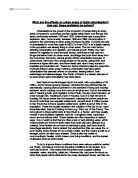Let us look firstly at the problem of rural depopulation. The migration of people away from the land can result in a shortage of labour, particularly acute during harvest. This may not be a great problem in industrialized regions, where the capital required for mechanised farming methods is readily available, but in developing countries there tends to be no substitute for traditional farm labour (ibid). The result of this is that, without the necessary workforce, food production will often not meet demand, and, as a consequence, prices will rise. During particularly poor harvests, the farmers themselves may not have enough to eat, and will be reluctant to send what little they produce to market. Maartens (1996) outlines the serious food shortages in the city which may result, and the political repercussions which are often known to follow.
A second consequence of rapid urbanisation has been overcrowding. Those moving from the land to the city are generally the poorest members of society. They also tend to bring with them rural traditions which are typified by large family groups, and family nuclei of ten or more sharing a room are not uncommon. If access to clean drinking water and safe sanitation is lacking (as is often the case), diseases of the digestive tract are common (FAO, 1993). Furthermore, damp conditions may exacerbate respiratory illnesses, and close human proximity encourages the transmission of infectious disease. High infant mortality is therefore a very common direct consequence of overcrowding. Indirectly, too, overcrowding may have negative effects. The sheer numbers of people in some urban centres may well restrict access to vital social services, such as hospitals and schools, thereby both increasing mortality rates still further, and preventing children from having an adequate education (FAO, 1995).
Having looked at the problems of rural depopulation and urban overcrowding, let us now look at a final aspect of rapid urbanisation in developing countries, that of the excess labour supply. The first to move to the city are often young males in search of work, but who are able to offer few skills relevant to urban life. The result of this large pool of manual labour is high unemployment; Maartens (1996:24) reports that figures of 50% are common in some of the largest cities. Without any reliable source of income, and often with large families to feed, poverty is very often a serious consequence. This can in turn lead to the spread of disease, as indicated above. As Tshombe (1999) points out, in extreme cases, crime may be seen as the only solution to unemployment, and may even result in urban unrest.
This essay has looked at three principal consequences of the recent rapid urbanisation in the third world, but it should not be imagined that each can be separated from the other so neatly. Clearly, the problems of rural depopulation and overcrowding are very closely related, as in turn are the problems of overcrowding and, for example, poverty. Unsurprisingly, such a complex and deep-rooted issue has, so far, resisted most attempted solutions. The responsibilities for finding effective responses lie both with the governments of the countries undergoing the process of development, and (in an increasingly globalised economy) with the already industrialised world.







